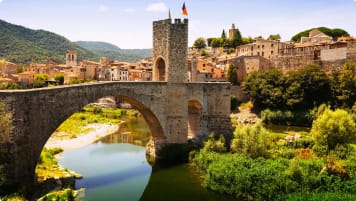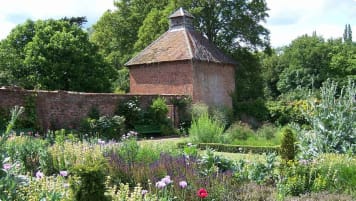Discover Oman
The Sultanate of Oman is a country of diverse natural beauties and fascinating human history. Oman boasts medieval forts and watchtowers, Bedouin villages, spectacular fjords, bustling markets, date palm plantations, and sand dunes.
From A$11,595AUD

Highlights
- 1. Experience Oman’s sense of timelessness in the ancient city of Nizwa.
- 2. Visit unique local markets including the Women only market.
- 3. Discover Muscat, Oman’s capital city, a unique blend of the ancient and the modern.
- 4. Visit a Bedouin house and enjoy coffee with the hospitable residents.
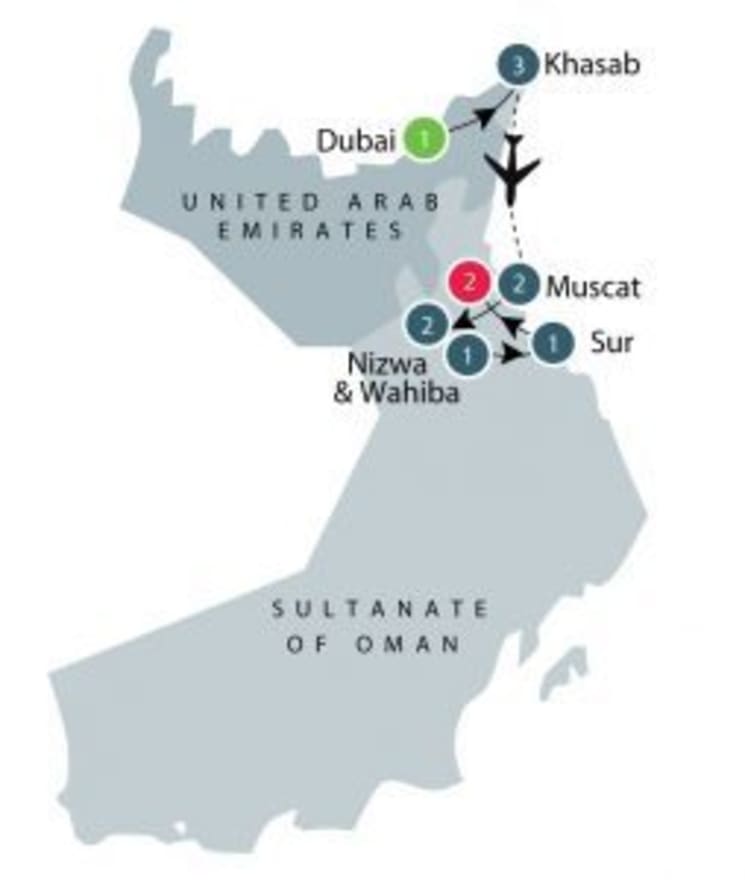
Departure Dates
| Departure Date | Price |
|---|---|
| 29 September 2025 Ends 11 October 2025 • 13 days A$12,185 Twin A$14,645 Single Available | Selected |
| 28 September 2026 Ends 10 October 2026 • days A$12,185 Twin A$14,645 Single Available |
Discover Oman | Small Group Tour
Odyssey offers easy, convenient, and relaxed escorted small group tours across Oman and the Middle East. We explore Oman's natural beauty along its coast, and its Persian heritage, its World Heritage Sites, with some truly spectacular scenery along the way. This and more is all waiting to be explored on one of Odyssey’s small group tours of Oman, designed for the senior traveller, and led by experienced, and enthusiastic like minded people.
The Oman small group tour explores the Sultanate of Oman, a country of diverse natural beauties and fascinating human history. Oman boasts medieval forts and watchtowers, Bedouin villages, spectacular fjords, bustling markets, date palm plantations, sand dunes, natural pools in the mountains, and a beautiful coastline. Oman enjoys an unspoiled culture and traditional lifestyle in almost every aspect. So even in modern times, Oman is distinctly Arabian and offers a glimpse of many unique old-world wonders.
During the Oman small group tour, participants experience the country's sense of timelessness. Together, we explore the ancient interior city of Nizwa, the coastal towns of Sur and Musandam, the capital city of Muscat, and the rich and fertile southern city of Salalah. All provide intriguing insights into the rich history and culture of Oman.
Tour highlights
Khasab Fort
One particular highlight of our educational tour is a visit to Khasab Fort. This picturesque stronghold was built in the 17th century by the Portuguese, who were seeking dominion over the maritime trade in the Strait of Hormuz. The fort was erected to prevent coastal attacks . Teak wood from India was used in its construction and its roof was fashioned from palm leaves and clay. The fort's low, crenelated walls contain a large central tower, which may predate the fort itself. The structure that exists today is the result of extensive restoration work completed in the late-20th century. Due to the fort’s location, it offers excellent views and spectacular photo opportunities.
Wadi Tawi
Another highlight is our journey to Wadi Tawi, where we explore prehistorical rock paintings depicting camels, ships, and warriors. Here, we also take a 4WD Mountain Safari to Jebel Harim. The drive takes in spectacular scenic routes through mountain and valleys, reaching a height of 1,784 metres above sea level with attendant panoramic views. We also visit the centuries-old village of Bait Ul Kufal and the lush natural park of Khalidiya with its many acacia trees.
Fjords of Musandam
Further highlights of our small group tour include exploring the spectacular fjords of Musandam, referred to as “Norway of Arabia,” due to its turquoise waters and white limestone cliffs. We also learn about the myths and legends of Salalah, which date back to biblical times. Our educational tour also includes a visit to a Bedouin house, where we enjoy coffee with the locals. We also experience a walking tour of Muscat, Oman’s capital city, a unique blend of ancient and modern culture.
The escorted Oman small group tour draws from some of the best local guides who share their knowledge of the contemporary and historic culture of Oman. The tour is ideal for the senior or mature couple or solo traveller seeking to explore and learn in a small group environment.
You can learn more about Oman with our country profile. For more details about this tour, click the ‘Top 5’ or ‘Itinerary’ buttons above! If you’re keen to experience this tour, please call or send an email. Or, to book, simply fill in the form on the right hand side of this page.
Gallery

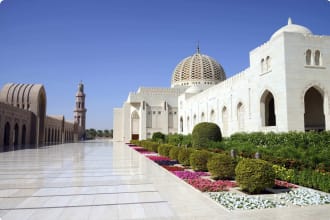
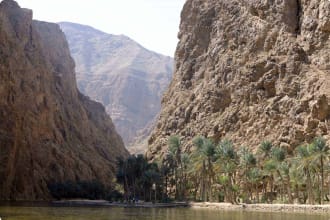
Itinerary
13 days
Day 1: Dubai
Accommodation: 1 night at Dubai hotel.
After making our own way to the hotel, we meet for a program orientation and welcome dinner.
(D)
Day 2: Dubai - Khasab
Accommodation: 3 nights at Golden Tulip Resort or similar
This morning, we transfer by private coach to our hotel in Musandam. Separated by the United Arab Emirates, Musandum is the northernmost part of Oman, jutting out into the Strait of Hormuz at the entrance to the Persian Gulf. The mountains rise straight out of the sea, giving rise to the fjord-like appearance of the coastline that is superbly visible from air.
Lunch today will be served at our hotel. Afterwards, the remainder of the day is at leisure. We come together again in the evening for a group dinner at the hotel.
(B,L,D)
Day 3: Jebel Harim & Khasab Town
Accommodation: Golden Tulip Resort or similar
This morning, we enjoy an excursion through the town, which provides an introduction to parts of the Musandam Peninsula and its capital of Khasab.
One highlight of the day is our visit to Khasab Fort. This picturesque stronghold was built in the 17th century by the Portuguese seeking dominion over the maritime trade in the Strait of Hormuz. The fort was erected to prevent attacks from the sea. Teak wood from India was used in its construction, and its roof was fashioned from a mix of palm leaves and clay. Within its low, crenelated walls, the fort contains a large central tower, which is thought to predate the fort itself. The structure that exists today is the result of extensive restoration work carried out in the late 20th century. The fort’s location offers excellent views and spectacular photo opportunities. Later on, we drive to Wadi Tawi, where one can see prehistorical rock paintings depicting camels, ships, and warriors.
In the afternoon, we enjoy a 4WD Mountain Safari to Jebel Harim. The drive takes in spectacular scenic routes through mountain and valleys, reaching a height of 1,784 metres above sea level with attendant panoramic views. We also visit the centuries-old village of Bait Ul Kufal and the lush natural park of Khalidiya, with its many acacia trees.
(B,L)
Day 4: The Fjords of Musandam
Accommodation: Golden Tulip Resort or similar
Today, we enjoy a half-day Dhow Cruise. This excursion will have great appeal for travellers who enjoy unusual experiences. After boarding our traditional Omani Dhow pier side, the cruise takes us towards Musandam’s longest and most spectacular fjord, which is often referred to as “Norway of the Arabia” due to the calm, turquoise waters that contrast with the creamy white limestone cliffs. Along the way we pass small fishing villages and perhaps even encounter dolphins.
The Dhow will anchor in the vicinity off Telegraph Island, allowing us to enjoy a swim or just sit back and enjoy soft drinks, tea, or coffee while admiring the breathtaking views of mountains rising in the distance to over 2,000 feet.
Dhows are motorised and very basic. There is the possibility of swimming off the Dhow, but caution is advised when getting in and out of the water via the Dhow’s ladder. Swimwear is acceptable for this tour only. Shady seating is available aboard the Dhow.
Lunch will be served on board the dhow or at local restaurant. In the afternoon, we are free to explore the quaint village of Khasab at our own pace.
(B,L)
Day 5: Khasab - Muscat
Accommodation: 2 nights at Park Inn By Radisson or similar
After breakfast, we transfer to Khasab Airport for our flight to Muscat. Our English-speaking guide will meet us at the arrival hall. We then transfer by private coach to our hotel in Muscat. This short drive to our hotel provides us with the first impressions of a clean and green capital. The rest of the day is at leisure.
(B)
Day 6: Muscat
Accommodation: Park Inn By Radisson or similar
Today we explore Muscat, Oman’s famous capital city. A unique blend of the ancient and the modern, Muscat is a beautiful, pristine city, which lies in the middle of a maze of brown pleated mountains, lulled by the Arabian Sea. The city has undergone dramatic development in the past two or three decades, but has never lost its strong heritage and culture.
We start our tour with a visit to the Grand Mosque, an architectural marvel that is perhaps the new landmark of the city. We then continue our drive through the ministries area, where we have the chance to see a number of modern buildings with touches of Islamic architecture.
Later on, we travel along the corniche to Old Muscat. Here we visit the Bait Al Zubair Museum / Bait Al Baranda Museum, where we learn about Omani history and culture. We pause at the magnificent Al Aalam Palace (the official residence of Sultan Qaboos), which is flanked by the twin Portuguese forts of Mirani and Jalali.
Lunch today will be at a local restaurant.
This evening is reserved for a special tour of one of the most popular places of Muscat, the enchanting Muttrah Souq, with its narrow covered alleys where the exotic smells of mounds of spices, coffees, ancient remedies, and enticing perfumes fill the air. This is our chance to explore the winding and zigzag alleys for a good bargain!
We then visit an Omani house to enjoy the hospitality of the Omani family. Our journey continues with a visit to the “Sidab Women’s Sewing Group (SWSG)” for dinner. SWSG is a non-profit community organization inspired and run by local women. The group helps women from this fishing village develop sewing skills so that they can create the handicrafts that earn them an income. This visit reflects of our desire to support and promote responsible tourism in the country. The women’s creations are colourful and reflect Omani culture, and we can choose to buy whichever product we like from their impressive gallery. Dinner tonight will be served on the terrace of the Sidab Women’s Sewing Group, where we will have the opportunity to interact with the craftswomen during dinner.
Women visiting the Grand Mosque are required to cover their heads with scarves and not wear shorts, beachwear, or sleeveless outfits. They will need to be fully covered, from hands until wrist and legs until foot. Men visiting the Grand Mosque should wear long trousers.
(B,L,D)
Day 7: Muscat - Nizwa
Accommodation: 2 nights at Golden Tulip Nizwa Hotel or similar
Today we travel through the fertile Batinah coast, which is dotted with beautiful beaches, forts, fishing villages, and sites famous for camel racing and bull fighting. The town of Nakhl lies in a secluded glen below the lofty mass of Jebel Nakhl.
While here, we visit Nakhl Fort, a 350-year-old fortress set in a gorge and surrounded by a mountain enclave. In 1990, restoration work began, using traditional building materials and period furnishings. The carved master gate is believed to date back to the 1830s, during the reign of Sayyid Said bin Sultan.
After visiting the fort, we continue on to the hot water springs. We commence our journey by ascending the Western Hajjar Mountains, which sit at just over 2,000 metres. On the way, we see beautiful villages with terraced farming. The mountain areas are also where Omani honey is produced. Beekeeping has been practised in Oman since ancient times. Here, the plants and trees flourish and provide honeybees with the nutrients they require: palm trees, coconut palms, cereals, limes, vegetables, sugar cane, frankincense, and gum trees. The specialist beekeepers of northern Oman are highly skilled in obtaining honey and propagating bee colonies in ways that are sustainable. In Northern Oman, the larger honeybee was traditionally kept in hollowed out trunks of date palms, locally known as tubl. When beekeepers require honey, they cut from the back of the tubl. Modern methods of beekeeping have now been introduced into Oma, which has increased honey production. Our guide will take us to one of the beekeepers, though the availability of honey depends on the season.
After our picnic lunch, we continue our drive across the mountain landscape and arrive at Nizwa. Dinner tonight is at our hotel.
(B,L,D)
Day 8: Nizwa
Accommodation: Golden Tulip Nizwa Hotel or similar
After breakfast, we travel to Jabreen, which was originally built as a defensive stronghold. Jabreen is perhaps the finest example of an Omani castle, and includes dungeons, passages, rooms, and ceilings decorated with fine carvings and paintings.
We continue our journey to the Western Hajjar Mountains, which rises over 2,000 metres. We pause at Al Hamra, where 400-year-old mud houses are still standing and occupied.
Later on, we stop for lunch at Bait Al Safah, a very old Omani house which is the cradle of heritage and history. Here, we learn about the history of ancestors who lived here, as it is a living example of how life was in Al Hamra during ancient times.
We also visit the mountain village of Misfah, and explore the stone dwellings and terrace farming in the village of Wadi Ghul. We continue to Jebel Shams, mountain of the Sun, the tallest peak in Oman at a height of 3,010 metres offering spectacular views of the surroundings. In the late afternoon, wee return to Nizwa.
(B,L)
Day 9: Nizwa - Wahiba Sands
Accommodation: 1 night at Desert Nights Camp.
Today we visit Nizwa Fort and the Nizwa Souq. The 17th-century round fort and Souq are famous for silver jewelry. Built on a solid base of rock, the huge tower was designed to withstand an attack from 24 cannons. A cattle auction takes place here every Friday. Forts and castles are Oman’s most striking cultural landmarks, and together with towers and city walls, they have historically been used as defensive bastions. It is estimated that there are over 500 forts, castles, and towers in Oman.
Today we witness the diversity of Oman’s landscape, from the dunes of Wahiba to oasis towns. Our drive takes us through a cross section of Oman’s arid lands, wadis, and oasis villages. After travelling through the town of Ibra, where there is a women’s souq every Wednesday, we get a glimpse of the amazing sand dunes. Lunch today will be at a local restaurant.
On the inland side of the great mountainous backbone of the Sultanate of Oman, where sands lap at the thresholds of farmlands, a string of border towns marks the zone of transition between nomadic and villagers. In the oasis villages of Oman, desert and village economies have merged for mutual benefit. Living along the sands are approximately 3,000 pastoralist Bedouins from different tribes (mainly herders of goats and camels). On our way, we stop at a Bedouin house where we will be welcomed with traditional Omani hospitality including an Omani “kahwa” and dates.
Running south from the Eastern Hajjar Mountains to the Arabian Sea, the Wahiba Sands, described a sand sea, stretch almost 200 kilometres in length and 100 kilometres in width. The dunes rise above 100-150 metres in different shades of colour and shifting sands. Here we enjoy a roller-coaster ride over the dunes.
Weather permitting, we enjoy a spectacular sunset over the dunes before our BBQ dinner.
(B,L,D)
Day 10: Wahiba Sands - Sur
Accommodation: 1 night at Sur Plaza Hotel or similar
The early morning provides a fantastic opportunity to explore the dunes by foot or to just watch the shifting colours of the dunes before our departure.
We then take the winding road up to Wadi Bani Khalid. The walk to the pools of Wadi Bani Khalid is fascinating, and traces along the falaj (small irrigation canals) past mango trees and other crops. On arrival, we have a refreshing break where we will be able to enjoy a swim.
We continue our drive towards Sur and enjoy lunch at our hotel. We then visit a Dhow building yard. Regrettably, in recent times, the amount of Dhows being built has significantly decreased.
We also visit the village of Ayja, a small town on the other side of Sur that lulled by the sea and quite charming with quaint houses on both sides of narrow alleys. Goats and sheep wandering the streets, and we will have time for a relaxing walk around the village.
(B,L)
Day 11: Muscat
Accommodation: 2 nights at Park Inn by Radisson or similar
After breakfast, we drive along the picturesque coastal road to Muscat. Our first stop is at Qalhat, one of the oldest towns and seaports in Oman. However, only the remnants of the city walls remain today. We visit the ruins of the tomb of the holy lady, Bibi Miriam, which stands high up on the cliff top.
We then continue to Wadi Tiwi, where we enjoy a walk through the narrow roads that lead us to lush plantations and pools with clear water. Here, we enjoy a packed lunch under the shades of palm trees. Our next stop is at the white sandy Fins beach for a swim, before we travel to Bimah Sinkhole, a spectacular limestone crater with blue green water at the bottom.
(B,L,D)
Day 12: Muscat
Accommodation: Park Inn By Radisson or similar
After breakfast, we visit the Omani Womens Association. The remainder of the day is at leisure, until our farewell dinner, which will be at a local restaurant.
(B,D)
Day 13: Muscat
After breakfast, we say our farewells and the tour draws to a close.
Tour Notes
- Group size is limited to a maximum of 16 participants.
Includes / Excludes
What’s included in our Tour
- Transport, lectures, and field trips as indicated.
- Services charges, hotel gratuities, and all local taxes.
- All domestic sightseeing and travel by first class air-conditioned vehicle.
- Domestic economy class air travel from Khasab to Muscat.
- Services of a Tour Leader throughout the tour.
- Applicable entry fees and services of local English-speaking guides.
- Detailed tour information booklet.
- 12 breakfasts, 9 lunches, and 6 dinners.
What’s not included in our Tour
- Items of a personal nature, such as telephone calls and laundry.
- Return economy class international airfare and departure taxes.
- Comprehensive travel insurance.
Participants must be able to carry their own luggage, climb and descend stairs, be in good health, mobile and able to participate in 3-5 hours of physical activity per day, the equivalent of walking / hiking up to 8 kilometers per day on uneven ground.
Book now
Make it a private tour
Easing your journey
Crossing international borders with restrictions
The list of requirements to travel internationally has changed and will continue to change for several years. Odyssey is here to assist you in managing your way through these requirements:
For more information see our Crossing international borders with restrictions page.
Book With Confidence
If less than 30 days before your tour starts you are unable to travel as a result of Government travel restrictions, Odyssey Traveller will assist you with a date change, provide you with a credit or process a refund for your booking less any non-recoverable costs.
See Terms and conditions for details.
Peace of Mind Travel
The safety of our travellers, tour leader, local guide and support staff has always been our top priority and with the new guidelines for public health and safety for keeping safe for destinations around the world, we’ve developed our plan to give you peace of mind when travelling with us.
See Peace of Mind Travel for details.
Reading List Download PDF
A History of modern Oman
Jeremy Jones, Nicholas Ridout
The ideal introduction to the history of modern Oman from the eighteenth century to the present, this book combines the most recent scholarship on Omani history with insights drawn from a close analysis of the politics and international relations of contemporary Oman. Jeremy Jones and Nicholas Ridout offer a distinctive new approach to Omani history, building on postcolonial thought and integrating the study of politics and culture. The book addresses key topics including Oman's historical cosmopolitanism, the distinctive role of Omani Islam in the country's social and political life, Oman's role in the global economy of the nineteenth century, insurrection and revolution in the twentieth century, the role of Sultan Qaboos in the era of oil and Oman's unique regional and diplomatic perspective on contemporary issues.
Arabian Sands
Wilfred Thesiger
Arabian Sands is Wilfred Thesiger's record of his extraordinary journey through the parched "Empty Quarter" of Arabia. Educated at Eton and Oxford, Thesiger was repulsed by the softness and rigidity of Western life—"the machines, the calling cards, the meticulously aligned streets." In the spirit of T. E. Lawrence, he set out to explore the deserts of Arabia, traveling among peoples who had never seen a European and considered it their duty to kill Christian infidels. His now-classic account is invaluable to understanding the modern Middle East.
In the Time of Oil: Piety, Memory, and Social Life in an Omani Town
Mandana Limbert
Before the discovery of oil in the late 1960s, Oman was one of the poorest countries in the world, with only six kilometers of paved roads and one hospital. By the late 1970s, all that had changed as Oman used its new oil wealth to build a modern infrastructure. In the Time of Oil describes how people in Bahla, an oasis town in the interior of Oman, experienced this dramatic transformation following the discovery of oil, and how they now grapple with the prospect of this resource's future depletion. Focusing on shifting structures of governance and new forms of sociality as well as on the changes brought by mass schooling, piped water, and the fracturing of close ties with East Africa, Mandana Limbert shows how personal memories and local histories produce divergent notions about proper social conduct, piety, and gendered religiosity. With close attention to the subtleties of everyday life and the details of archival documents, poetry, and local histories, Limbert provides a rich historical ethnography of oil development, piety, and social life on the Arabian Peninsula.
Oman: Under Arabian Skies
Rory Patrick Allen and Alan Pelz-Sharpe
The Sultanate of Oman is a land of oases, deserts, rolling sands, shifting dunes, and mountains upon which ancient cities have been carved from stone. A land that boasts the Queen of Sheba, Sindbad the Sailor, and The Lost City of Ubar buried for millennia under the Arabian Sands. A country that was heralded for its wealth in frankincense, and it is from here that ancient frankincense caravans began carrying their precious cargoes to the classical world.
Oman is a country where the Bedouin still wander the deserts as they have since time immemorial. A mystical land where eagles soar over the mountain that is home to the prophet Job, a prophet in Judaism, Christianity, and Islam.
In the mountains nearby live an ancient people whose language predates Aramaic. The age of the language remains a mystery. It is a spoken language with no written form. In these mountains one finds caves that are decorated with prehistoric art. Mines and distinctive cone-like tombs dating from the Bronze Age feature all over the country. It is a land that has tales of wizardry, magic, jinns, and exorcisms. Embark on a magical and mystical Arabian Odyssey with one man and his traveler's tales through this land that time has all but forgotten.
OMAN "Under Arabian Skies"
Rory Patrick Allen
The Sultanate of Oman is a land of oases,deserts, rolling sands, shifting dunes and mountains upon which ancient cities have been carved from stone. A land that boasts the Queen of Sheba, Sindbad the Sailor and The Lost City of Ubar buried for millennia under the Arabian Sands. A country that was heralded for its wealth in frankincense and it is from here that ancient frankincense caravans began carrying their precious cargoes to the classical world. Oman is a country where the Bedouin still wander the deserts as they have since time immemorial. A mystical land where eagles soar over the mountain that is home ot the prophet Job, a prophet in Judaism, Christianity and Islam.
In the mountains nearby live an ancient people whose language predates Aramaic. The age of the language remains a mystery. It is a spoken language with no written form. In these mountains one finds caves that are decorated with prehistoric art. Mines and distinctive cone like tombs dating from the Bronze age feature all over the country. It is a land that has tales of wizardry, magic, jinns and exorcisms. Embark on a magical and mystical Arabian Odyssey with one man and his traveller's tales through this land that time has all but forgot.
Oman: The True-Life Drama and Intrigue of an Arab State
John Beasant
Oman is one of the world’s most secretive countries,ruled with absolute authority by the Sultan. All information is strictly controlled by the State: British Prime Minister Edward Heath once said that the story of the 1970 Palace Coup and the events that followed would ‘not be told in our lifetime’.
Following ten years’ residency in the country a senior member of Sultan Qaboos's Family suggested that John Beasant write a political history of Oman that would to some extent rehabilitate the maligned name of former Sultan Said, who was deposed in the 1970 Coup.
In 'Oman' Beasant catalogues a nature of exploitation woven through all manner of political and commercial interests and casts light on the dark practices so often involved in the sale of arms to Middle Eastern states and illustrates the political use to which the sale of ‘black gold’ - oil - can be put.
Oman is a parable of our times, detailing rivalry and intrigue between people in high places. It is one of the most dramatic tales in Arab history: a chronicle of personal price, rapacious greed and undiluted lust for power.
Arabs: A 3,000-Year History of Peoples, Tribes and Empires
Tim Mackintosh-Smith
History of Oman: Government, Politics, Economy, Society, Religion, Tourism
Bonna Walter
Oman History. As a regional commercial power in the nineteenth century, Oman held territories on the island of Zanzibar off the coast of East Africa, in Mombasa along the coast of East Africa, and until 1958 in Gwadar (in present-day Pakistan) on the coast of the Arabian Sea. When its East African possessions were lost, Oman withdrew into isolationism in the southeast corner of the Arabian Peninsula. Another of the gulf states with long-standing ties to the British, Oman became important in the British-French rivalry at the end of the eighteenth century, when Napoleonic France challenged the British Empire for control of the trade routes to the East. Although nominally a fully independent sultanate
Our Women on the Ground: Arab Women Reporting from the Arab World
Zahra Hankir
Nineteen Arab women journalists speak out about what it's like to report on their changing homelands in this first-of-its-kind essay collection.
A growing number of intrepid Arab and Middle Eastern sahafiyat - female journalists - are working tirelessly to shape nuanced narratives about their changing homelands, often risking their lives on the front lines of war.
Here, nineteen of these women tell us, in their own words, about what it's like to report on conflicts that (quite literally) hit close to home. Their daring and heartfelt stories, told here for the first time, shatter stereotypes about the region's women and provide an urgently needed perspective on a part of the world that is frequently misunderstood.

